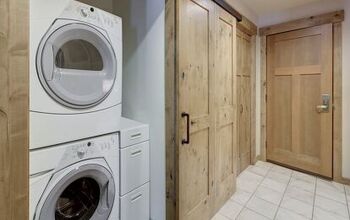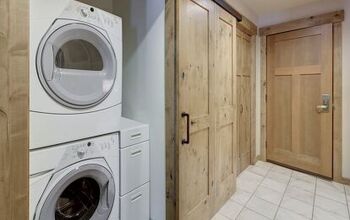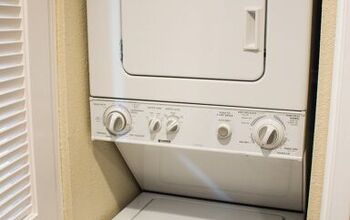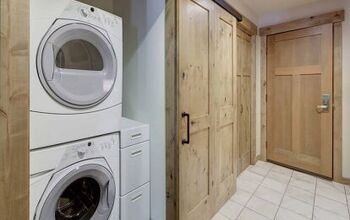How To Stack A Washer And Dryer Without A Kit

When planning the layout of a home, space is your priority. Often, the laundry room is the lowest on the list. Even if you are lucky to have a spacious laundry room, there’s always a possibility to optimize the use of the space you have. This is where stacking your washer and dryer comes in handy, but what if you don’t have a stacking kit? Can you still stack them?
To stack a washer and dryer without a kit, place an Enviro Rubber APL600 rubber mat on top of the washer to minimize movement. The dryer and washing machine must be the same width or the washer must be larger than the dryer. You should only use rubber mats with a vented dryer. Or, you can mount your dryer to the wall.
In this article, we will talk about the convenience of stacking your washer and dryer. We also let you know how to do this without a kit and provide another safe alternative. We will help you weigh your options so that you can optimize your space using the method you best see fit.
Do You Need Appliance Installation or Replacement?
Get free, zero-commitment quotes from pro contractors near you.

Why Stack Your Washer And Dryer?
A useful and easy way to make more efficient use of your space is to relocate the dryer onto the top of your front-loading washing machine so that they’re stacked. Stacking not only takes up 50% less floor space, but it also makes it much easier to load and unload your dryer.
You don’t have to carry heavy, wet laundry across the room, and you don’t have to bend over as you pull it out. This is not only more convenient, but it also reduces the possibility of back injuries.
Your Washer And Dryer Need To Be Suitable For Stacking
Contact a local retailer, or visit your manufacturer’s website to ask about whether or not your appliances are suitable for stacking. Typically, any washing machine and dryer can be stacked together, providing the dimensions (in terms of width and depth) are identical, or if the base of the washer covers a greater area than the bottom of the dryer.
What Is A Stacking Kit?
A stacking kit is a piece of laundry equipment that you can use to sit in between a dryer and a front-loading washing machine. As well as creating more floor space, it guarantees that the two heavy items are joined together safely as a single unit.
Stacking kits are able to spread the weight of the dryer evenly as it rests on the washing machine. It can also handle the vibrations from the two appliances when they are operating simultaneously. This means that the dryer will stay in place on the washing machine and not become dislodged.
Can You Stack Your Washer And Dryer Without One?
Luckily, you have another option. You can purchase an Enviro Rubber APL600. You can use this piece of rubber matting to handle the vibrations caused by either the dryer, the washer, or both at the same time.
In addition, the APL600 can be useful in other areas of your home, such as the kitchen. When placed below a dryer, it absorbs any vibrations and decreases the volume of noise the appliance makes. This mat also makes a floor more even if it’s not entirely level. This is often the case in bathrooms or laundry rooms, where a slight slope assists the water to flow in the direction of a drain.
Stacking Your Washer And Dryer Without A Kit Or Rubber Mat
It is possible to stack without a kit or rubber mat; however, we advise you not to do it. While a dryer typically creates fewer vibrations than a washing machine while in use, there’s still a risk it can fall off your washing machine. Consider the consequences for your appliance and the cost of repair or replacement. It may also damage the floor, which would then need to be repaired.
Additionally, if your dryer has vibrated forward and someone either tugged hard at the door of the dryer or even heaved out a load of laundry, it could be pulled off the washing machine. Imagine the injuries that could cause, in addition to the damage to the dryer and floor. We strongly advise against stacking without a kit or a rubber mat due to the risks involved.
Alternative To Stacking Your Laundry Appliances
As an alternative to sitting the dryer on top of the washing machine, it is possible to attach it to the wall using brackets. This optimizes the use of available wall space and reduces unnecessary bending as you load and unload laundry. It is, therefore, not only convenient but also safer for your back.
If your washing machine is a top-loader, this is a perfect solution. While it’s obviously not possible to stack a dryer on a top-loading washing machine, you still have the option to move it off the floor. This still allows you the convenience to load and unload your laundry as well as optimize your laundry space. Not to mention, it’s a safer solution to stacking without a kit or a rubber mat.
Important Note When Mounting Your Dryer To The Wall
Vented dryers, which remove water from laundry in the form of steam, are the only type of dryers that can be wall-mounted. Condenser dryers collect the water they remove in a tank. They are too heavy for wall-mounting, and it would not be safe to do so. However, it is possible to stack them.
It is quite common for wall-mounted vented dryers to be fixed upside down. The reason for this is that the controls will be within easier reach. If your model is suitable for this option, it will usually have a set of stickers so that the controls can be more easily read and understood. To confirm whether your appliance can be used upside down, consult the user guide, or check online with the manufacturer.
You May Need To Slightly Renovate
It’s essential to be aware that wall-mounting a dryer safely will require some work in the laundry room, which will affect the supporting wall. If you’re renting your home, you’ll need to obtain your landlord or agent’s approval prior to starting work.
Sometimes, installing steel plates into the wall for additional support will help as well. The drywall itself will not hold the dryer. You can choose to hire a professional to check your wall’s structure to ensure that wall mounting is a safe option for you.
DIY Safety Note
If you decide to stack your washer and dryer yourself, you may need some assistance as dryers are extremely heavy, and you won’t be able to lift it yourself. Besides, if anything goes wrong, you’ll at least have someone there to help you in the case of an emergency.
Related Questions
What should I look for when buying a stackable washer and dryer?
The most important thing when it comes to stackable washer and dryers is that your washer is front loading. It is not safe to set a washer on top of a dryer as it is too heavy, and the vibration will cause it to fall. However, if you have a top-loading washer, you may be able to mount your dryer to the wall instead.
Can you lay a stackable washer and dryer down to move it?
Do not lay a stackable washer and dryer on its side, back or front. This will cause the drums to put pressure on fragile components and break something inside your appliances.
How much space is needed for a stackable washer and dryer?
You will need a minimum of about 32 inches wide and 40 inches deep for a stackable washer and dryer. For a side-by-side set, you will need 40 inches deep and about 56 inches wide.
Do You Need Appliance Installation or Replacement?
Get free, zero-commitment quotes from pro contractors near you.

Our Takeaway
Having a stackable set of laundry appliances will help you optimize your laundry space; however, you shouldn’t do this if you can’t do it safely. If you don’t want to use a stacking kit or a rubber mat, you can look into mounting your dryer to the wall as an alternative. No matter what you choose to do, safety should be your number one priority.
Related Guides

Heather is a passionate writer who loves anything DIY. Growing up, she learned everything from home repairs to design, and wants to share her tips with you. When she's not writing, she's usually hiking or searching for her next DIY project.
More by Heather Robbins




















![How To Reset A Whirlpool Cabrio Washer [In 5 Easy Steps!]](https://cdn-fastly.upgradedhome.com/media/2023/07/31/9076531/how-to-reset-a-whirlpool-cabrio-washer-in-5-easy-steps.jpg?size=350x220)






